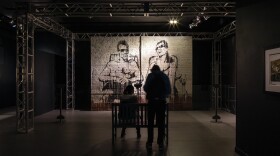Artist Glynn Galloway combines old items and wet leather into pieces that are ‘a little bit edgy’
Driftwood, doll heads, vintage radio antennas, scrap metal, old burlap sacks — rather than seeing this as useless junk, Las Vegas artist Glynn Galloway sees potential for art. His assemblage pieces combine antique trinkets, in all their rusted, patinaed, imperfect glory, along with new materials, like molded leather.
Galloway, who served in the Navy for almost 25 years and has worked in healthcare for much of his life, didn’t anticipate becoming an artist. With no formal training — not even a single art class — he began creating assemblage pieces in 2009. Ten years later, he spends his days in his home studio, where bins of carefully curated materials line the walls, and prosthetic legs hang from the ceiling.
“Almost every piece that I do, I try to tell a story,” he says. “Not every piece has to send a message, but every piece has some meaning behind it.”
One of his cornerstones is wet-molding leather, a technique that he modified from the ancient process of hardening leather known as cuir bouilli, which translates to “boiled leather.” With Galloway’s method, the leather retains its suppleness, making it easier to sculpt, often into emphatic human faces, organs, and structures that range from whimsical to grotesque. Galloway’s new exhibit is titled Leather or Knot.
What makes leather a fitting material for your work?
I love the way it can be manipulated. By wetting it you can tool it with stamps and indent it to make designs, and you can also mold it like clay. You could dye it, you could pyrograph it, you could use a wood burner on it and make designs into it, you could airbrush paints on it, you could use gold leaf on it. I found it a very versatile medium, and I’m one of the few artists in the country who uses leather on a regular basis.
Most of my pieces are based on antique objects, and I like to find pieces that are handmade or hand-forged — it’s like doing a collaboration with someone from the past.
I found that I wanted to do more than just assemble objects, and the way I found to do that was to use leather.
Even in abstract pieces, your depictions of human faces and organs look strikingly realistic. How does your medical background inform that?
There’s certainly a lot of anatomical references to my work, and I think that’s because I’ve worked in the operating room for so many years. I use glass eyes, human bone, prosthetic limbs. I always want things to be a little bit edgy, and sometimes using those references can get the reaction you’re looking for, whether it’s favorable or unfavorable.
I always say my artwork is not for every living room because of that. It can be a little grotesque sometimes. But I try to make it so people can enjoy it even if it is a little morbid. One artist said to me, “You seem to find the perfect mixture of sinister and sweet.”
You’ve talked about being interested in the “character of imperfection.”
I enjoy trying to find pieces to incorporate into my artwork that other people have absolutely no use for, and a lot of times it’s a piece of metal that’s broken, that you can’t repair or can’t use for any purpose. I just feel like that imperfection adds a real quality to the art that you can’t reproduce.
Utilizing unique materials is clearly a vital part of your work.
If you watch a chef pick out a tomato, he looks at the color, he’ll pick it up, he’ll feel it, he’ll smell it. I kind of do the same thing with every component I choose for a piece. I love things that have a patina or have a grain that you can not only see but feel.
I want people to be able to touch the artwork; I think that’s really an important part of experiencing art. When I do outdoor shows, I put signs out that say “feel free to touch the artwork.” I encourage it.








